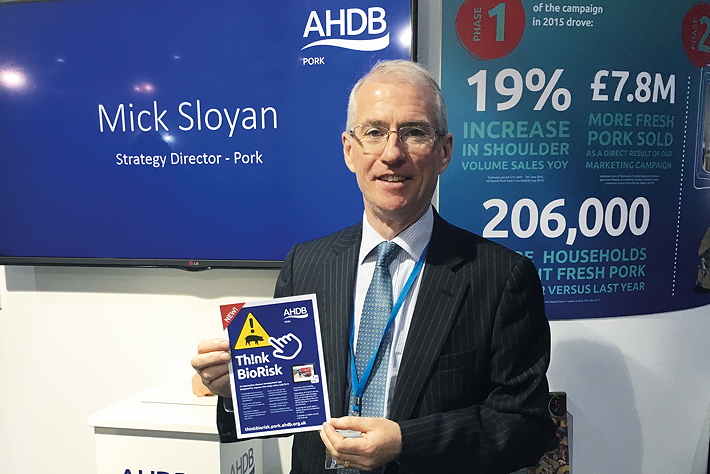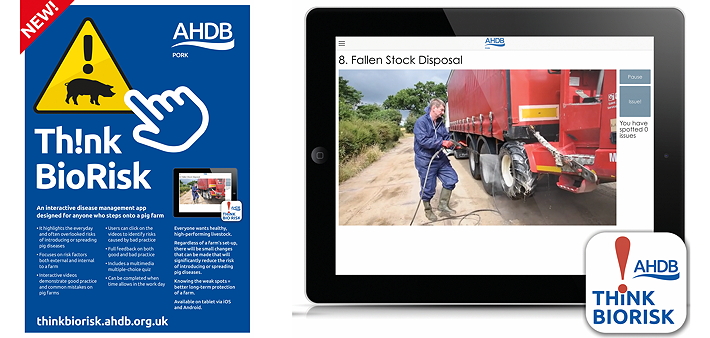AHDB Pork launched Think BioRisk at this year’s Pig & Poultry Fair. A new interactive app, it’s been designed to be used by anyone who steps onto a pig unit with a view to improving disease management
The threat of disease remains a constant concern for the pig industry, and new and emerging diseases are only likely to increase this pressure. However, if everyone stepping onto a unit can stop, consider disease management and think about their actions before entering, then, as an industry, we can help keep disease out, minimise it from spreading and improve productivity.
Introducing the app at the fair, AHDB Pork’s strategy director, Mick Sloyan, explained how important it was that anyone entering a pig unit understood and implemented best farming practices at all times to keep pig health up and costs down.
“All units should be working towards or maintaining a high herd health status as a priority because poor disease management costs money and could prove disastrous for the British pig industry in the case of a disease outbreak,” he said. “What’s more, by proactively improving the health of pigs, it means that we can take every opportunity to reduce antibiotic usage, which is important given the current pressures and will also help producers cut their costs.
“Many holdings have disease management protocols in place, but we appreciate that, when busy, it’s easy to become wrapped up in day-to-day activities and, as other priorities take hold, key risks with regard to herd health are often overlooked.
“This is where we hope Think BioRisk will help. We anticipate that the app will be a really valuable resource for the entire industry, reminding users of the everyday and often overlooked risks of introducing or spreading diseases, focusing on both external and internal factors.”
The interactive video scenarios, available for both indoor and outdoor production, demonstrate good practice as well as common mistakes, and ‘click identification’ allows users to highlight risks caused by bad practice.
“It’s a bit like the hazard perception part of a driving test and, on completion, full feedback is provided,” Mick said. “It’s an ideal tool for training in good disease management, and has the added benefit that it can be completed when time allows in the working day.
“By helping people understand the weak spots of disease management, we hope we can achieve better long-term protection of the industry.”
Disease management
AHDB Pork’s veterinary team manager, Martin Smith, said there were a number of modules that are covered by the app and they are all important to disease management.
“Some examples of the training modules include: visitors, vehicles, movements of staff and livestock, pest control, medicine management and deadstock collection; all of these are potential weak points on a unit, and that’s why they’ve been covered,” he said. “It’s particularly important that all unit staff are well informed about disease management and understand that high standards are key to effective disease control. For this reason, it’s essential that all staff are provided with the information and training they need to maintain strict standards of hygiene.

“After all, they’re the ones coming into daily contact with the pigs, and you want them to be informed so they can spot the risks and think before putting themselves or the stock at risk,” he added. “For example, the app highlights that overalls and boots worn on a unit should only be worn on that unit. It also goes into detail about the importance of this and the role it can play in preventing a disease outbreak.”
The app also features a module about visitors to a pig unit, and gives practical advice about protocols that should and shouldn’t be followed.
“If possible, all visits should be prearranged and entry should be made via a single point, where clean boots and overalls should be put on and hands washed using the facilities provided,” Martin said. “As part of the Red Tractor assurance scheme, a visitor’s book must be made available for completion by all visitors before entry, confirming that they’re complying with the unit requirements to minimise any potential biosecurity risks.”
Feed deliveries
Incoming and outgoing stock, and feed deliveries, are other movements that should be considered with regard to disease control, and are covered in the app.
“In an ideal world producers should try to locate feed bins on the boundary of the unit to prevent vehicles from entering when delivering feed as this increases the risk of disease breakdown,” Martin added.
“Also, each individual unit should provide a bulk feed pipe for use with all deliveries, rather than using the vehicle’s own pipes. In addition, all bulk bins should be regularly emptied and cleaned to ensure that they remain watertight and dry.
“It’s particularly important that producers are always aware that the most common method of disease transmission is through direct pig-to-pig contact, and for this reason, when setting up contracts for deliveries of new stock, it’s really important to check the health status of the source before introducing them to the main herd.
“Where possible, all incoming replacement breeding stock should be isolated, ideally on a separate site or on the perimeter of the unit, with specific staff and equipment used to handle the pigs to minimise the risk of cross contamination.”
Deadstock management is covered by Think BioRisk and the take-home message is that any carcases should be disposed of as quickly as possible and in line with legal requirements, which requires safe, sealed storage containers.
“If collection is made by a third party, it’s important to provide a collection point away from pig buildings with a clear separation between the farm access and the collection service access,” Martin said. “The collection point and associated equipment should also be thoroughly cleaned and disinfected after every collection.
“Regardless of your farm set-up, or whether you’re a delivery driver entering units, there’ll be small changes that you can make that will significantly reduce the risk of introducing or spreading pig diseases, which in turn will lead to better long-term protection of the UK pig industry.”
* * * * *
What is Think BioRisk?
This new interactive app is designed for anyone who steps onto a pig unit. It offers the following benefits:
- highlights the everyday and often overlooked risks of introducing or spreading pig diseases, focusing on both external and internal factors;
- uses interactive video scenarios to demonstrate good practice and common mistakes on pig farms;
- scenarios are available for both indoor and outdoor production;
- topic areas cover all common aspects of disease risk to a farm;
- the videos allow ‘click identification’ of risks caused by bad practice;
- full feedback on both good and bad practice portrayed in the videos;
- a multimedia multiple-choice quiz further demonstrates on-farm risks;
- can be completed when time allows in the work day; and
- is an ideal tool for training.
Think BioRisk can be downloaded from: http://thinkbiorisk.pork.ahdb.org.uk




